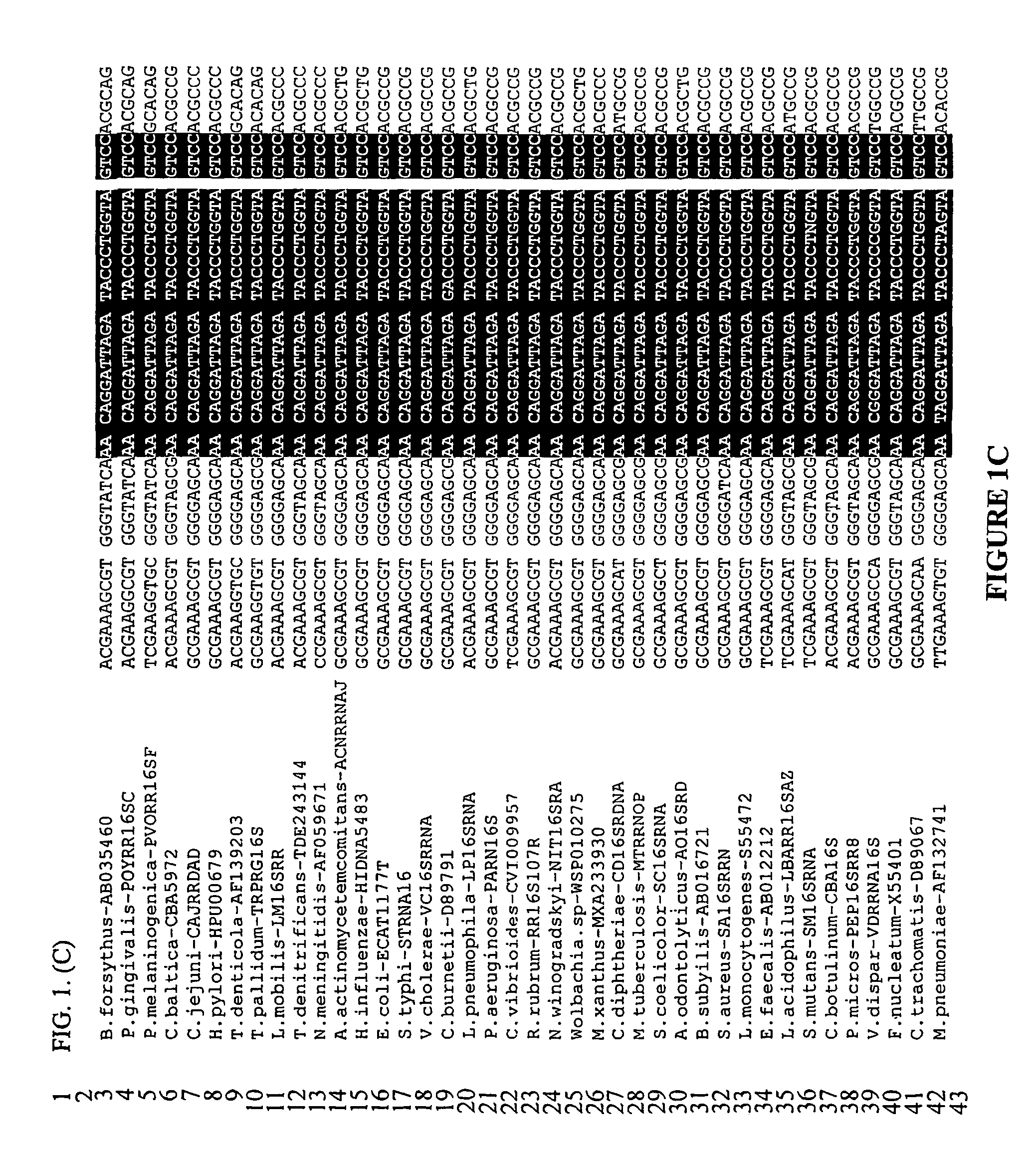Method of detecting microorganisms
a microorganism and detection method technology, applied in the field of detecting microorganisms, can solve the problems of microbial culturing techniques producing erroneous results, optically too similar, and several days to yield, and achieve the effect of accurately determining the total bacterial load and wide specificity
- Summary
- Abstract
- Description
- Claims
- Application Information
AI Technical Summary
Benefits of technology
Problems solved by technology
Method used
Image
Examples
example 1
Bacterial Strains and Culture Conditions
[0109]Escherichia coli strains JM109, NM522 and XL 1 blue (Stratagene, La Jolla, Calif., USA) were available from previous studies. Staphylococcus aureus strains ATCC 12600, ATCC 9144, ATCC 12598, ATCC BM 10458 and ATCC BM 1014; Staphylococcus epidemidis strains ATCC 35983 and ATCC 14990; Staphylococcus hemolyticus ATCC 29970 and S. hemolyticus-infiltrative keratitis isolate; Staphylococcus schleferi ATCC 43808; Pseudomonas aeurginosa strains ATCC 19660, ATCC 15442, ATCC 6294 and ATCC 6206; Pseudomonas fluorescens-infiltrative keratitis isolate; Pseudomonas putida-lens saline isolate; Pseudomonas stutzeri-infiltrate isolate; Pseudomonas alcaligens laboratory-isolate; Pseudomonas species and Serratia marcescens ATCC 274 were provided by the Co-operative Research Centre for Eye Research and Technology, The University of New South Wales, Australia. All Escherichia, Staphylococcus, Pseudomonas and Serratia species were grown in Luria Burtanni brot...
example 2
Source of Carious Dentine
[0110]Twenty carious teeth were obtained with informed consent from randomly selected patients who presented with pain and requested extraction to relieve their symptoms. Patients were excluded from the study if they reported a history of significant medical disease or anti-microbial therapy within the previous four months. Unrestored teeth with coronal enamel and dentine caries were selected for inclusion in the study on the basis of clinical diagnostic tests which indicated that they were vital, with clinical symptoms of reversible pulpitis (pain and heightened sensitivity to hot and cold stimuli).
[0111]Immediately after extraction, each tooth was placed in a container of reduced transport fluid (RTF) (24) and transferred to an anaerobic chamber at 37° C. containing 85% N2, 5% CO2 and 10% H2 v / v / v. Superficial plaque and debris overlying the carious lesion was removed and the surface rinsed several times with RTF. Using sterile sharp excavators, all the so...
example 3
Determination of Colony-forming Units in Carious Dentine
[0112]The carious dentine extracted from each tooth was individually weighed and a standard suspension of 10 mg wet wt dentine (ml RTF)−1 was prepared at 37° C. in an anaerobic chamber (see Example 2). The dentine fragments were homogeneously dispersed in RTF by first vortexing for 20 s and then by homogenizing by hand in a 2 ml glass homogenizer for 30 s. Samples (100 μl) of 10−3 to 10−6 serial dilutions of these suspensions were prepared in RTF and plated in duplicate onto Trypticase Soy agar (Oxoid) containing 1 μg menadione ml−1, 5 μg haemin ml−1, 400 μg L-cysteine ml−1 (Sigma) and 5% v / v horse blood (Amyl Media) (10). The plates were incubated at 37° C. in an anaerobic chamber containing 85% N2, 5% CO2 and 10% H2 v / v / v for 14 days and the number of colony-forming units counted to determine the total microbial load (mg wet wt of dentine)−1. The unused dispersed carious dentine samples were frozen at −80° C.
PUM
| Property | Measurement | Unit |
|---|---|---|
| Electrical conductance | aaaaa | aaaaa |
| Mass | aaaaa | aaaaa |
| Mass | aaaaa | aaaaa |
Abstract
Description
Claims
Application Information
 Login to View More
Login to View More - R&D
- Intellectual Property
- Life Sciences
- Materials
- Tech Scout
- Unparalleled Data Quality
- Higher Quality Content
- 60% Fewer Hallucinations
Browse by: Latest US Patents, China's latest patents, Technical Efficacy Thesaurus, Application Domain, Technology Topic, Popular Technical Reports.
© 2025 PatSnap. All rights reserved.Legal|Privacy policy|Modern Slavery Act Transparency Statement|Sitemap|About US| Contact US: help@patsnap.com



